
Photo/Illustration: H. Ross Hawkins
Besides their scented foliage and beautiful flowers, there are additional reasons why I’m attracted to the plants of the genus Agastache (commonly known as either hyssops or hummingbird mints, depending on where you live). They thrive in tough, dry conditions and aren’t attractive to browsing deer. Each one has a scent all its own, and the aromatic foliage and flowers are appealing to bees, butterflies, hummingbirds, and gardeners alike. Perhaps best of all, they offer color to the garden in late summer and early fall, when many gardens are winding down and getting a bit dull.
Hyssops and Hummingbird Mints
Agastache spp. and cvs.
(ag-ah-STAK-ee)
HARDINESS: A genus of about 22 species of aromatic perennials, 21 of which are native to North America. Most are hardy in USDA Hardiness Zones 5 to 9.
APPEARANCE: These plants form clumps that grow from deep-rooted crowns. The flowering spikes, which vary in size according to species, are formed at the branch tips and are composed of closely spaced flowers.
CONDITIONS: They prefer full sun, good air circulation, and lean, dry soil.
PESTS AND DISEASES: Winter mulching with organic matter can result in fungal and bacterial growth. These plants are highly resistant to browsing animals.
PROPAGATION: Nonhybridized species like A. rupestris and A. rugosa are readily grown from seed. Hybrid cultivars are propagated by rooting softwood cuttings in the spring or early summer before flowering. When different Agastache species and hybrids are planted in the same garden, they will cross-pollinate readily. Watch for volunteer seedlings, and weed out individual plants that don’t demonstrate desirable habit and flower color.
Small-flowered hyssops are herb garden classics
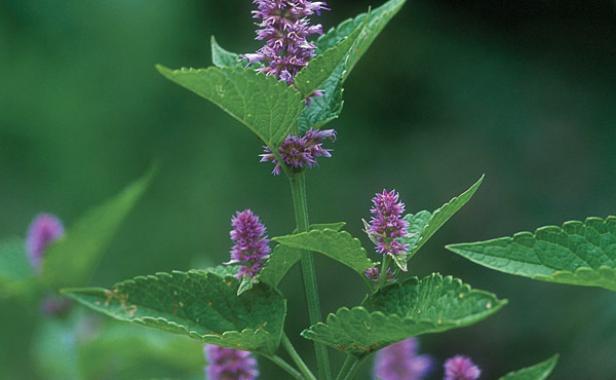
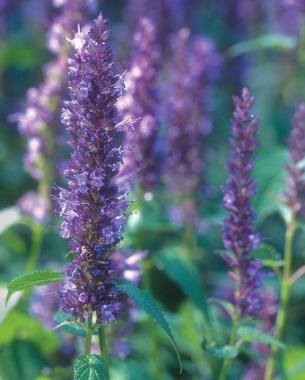
Photo/Illustration: Lee Klopfer
Similar to anise hyssop is Korean hyssop (A. rugosa, Zones 5–9), with deep violet–blue flowers atop glossy green foliage that grows up to 24 inches tall and 15 inches wide. If you keep Korean hyssop deadheaded, the flowers will keep blooming all summer long.
‘Blue Fortune’ hyssop (A. ‘Blue Fortune’, Zones 5–10) is a hybrid of A. foeniculum and A. rugosa with spikes of powder blue flowers held over large deep green foliage. The plant stands approximately 36 inches tall with a mature width of 18 inches. Peak bloom occurs in midsummer when butterflies are plentiful.
A. foeniculum, A. rugosa, and ‘Blue Fortune’ grow well in not only compost-enriched garden loam but also lean, dry soil. These three varieties of hyssops are cold hardy and are tolerant of wet winter and spring soils. This makes them adaptive in most parts of the country. Their clusters of small flowers are especially attractive to bees and butterflies.
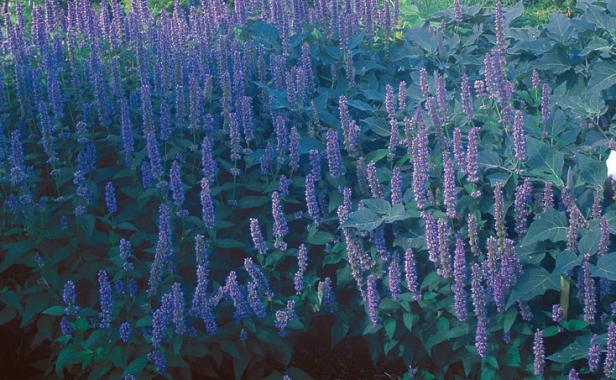
Large-flowered varieties are on the rise
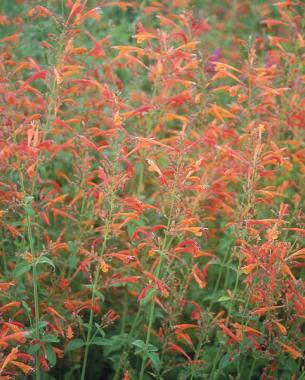
It is only within the past decade that a number of other noteworthy members of the genus Agastache have emerged from botanical obscurity and entered the gardening spotlight. There are a number of standouts that will dazzle gardeners with their copious flowers, statuesque growth habits, and amazingly long seasons of bloom. These newer selections are from the southwestern United States and from Mexico. While the small-flowered species and hybrids, such as anise hyssop, attract butterflies and bees, the large-flowered varieties have coevolved with hummingbirds as their primary pollinators and have long flowers in shades of orange, pink, lavender-pink, and rose-pink.
Texas hummingbird mint (A. cana, Zones 5–9) is a showy, rose-pink species, native to New Mexico, that grows up to 36 inches tall and 18 inches wide. Sunset hyssop (A. rupestris, Zones 4–9) is another showy species, native to the mountains of southwestern New Mexico and eastern Arizona, with soft orange flowers, gray-green threadleaf foliage, and a spicy, licorice-mint scent. In 2000, High Country Gardens introduced ‘Desert Sunrise’ (A. × ‘Desert Sunrise’, Zones 5–10), a cross between these two showy, cold-hardy species. This hybrid cultivar reaches a height of 40 to 48 inches with a spread of 24 or more inches. The plant’s flower color and perfumed foliage are a perfect mix of the parents. The pleasing, herbal-scented spikes have lavender-pink calyces with contrasting orange-pink corollas. Grown in lean, well-drained soil (see below), the plant is long lived, is cold hardy to Zone 5, and produces large quantities of flowers from late summer through hard frost in fall.
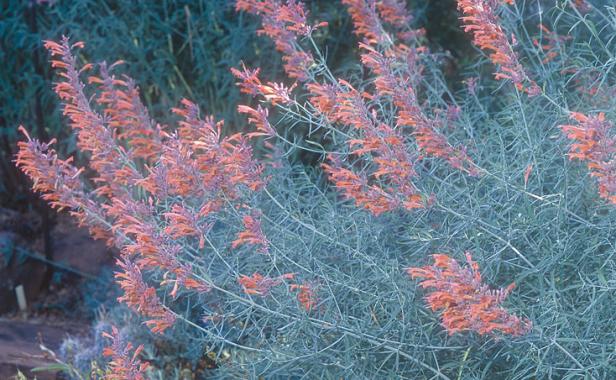
They thrive in spartan conditions
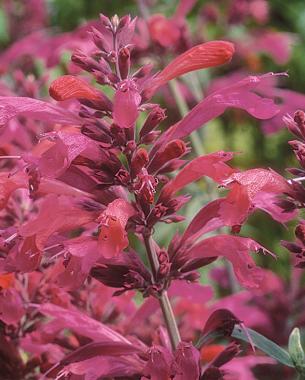
Photo/Illustration: Lee Klopfer
Hyssops are an easy-to-grow group of plants. For gardeners interested in growing hyssops, I often ask if they have had success growing lavender. If so, then hyssops will be a welcome addition to their gardens, as the two seem to enjoy the same growing conditions. As is typical of many aromatic perennial herbs, a “tough love” approach works best—full sun and not too much water or fertilizer. In fact, most plants will need little, if any, supplemental irrigation. In dry climates, a deep soaking every week or two during the summer growing season is adequate. When overfertilized or grown in soil that is too rich, the plants get floppy and do not flower well. A single application of high-quality compost or other low-nitrogen fertilizer in mid to late fall is all they need.
Take care when mulching hyssops, especially in wetter climates. In these areas, it is best to avoid mulching materials like composted leaves, lawn clippings, and bark chips since they can encourage the growth of fungal and bacterial pathogens. Pine needles are a better choice, but crushed-gravel mulch is ideal. A few inches of 12-inch-diameter or smaller gravel works best.
Growing hyssops in clay soil
If you want to grow hyssops but you garden in clay soil or in wet conditions, I recommend improving your soil’s drainage. You can do that by amending the soil and growing the plants on berms or in raised beds.
SOIL RECIPE
2 parts coarse sand or fine gravel
1 part native soil
1 part high-quality compost
Trace element fertilizer at the recommended rate
Optional
1 part sand in areas with high precipitation
• Mix thoroughly, choose a sunny location with good air circulation, and pile the soil to create a berm or fill a raised bed.
• Be sure to dig some of the blended soil into the ground below the berm or bed as it is filled so water will drain into the native soil below.
• Water plants weekly during the first growing season to make sure they get established in this fast-draining mixture. In subsequent years, the plants should be self-sufficient.
Combine hyssops with other perennials
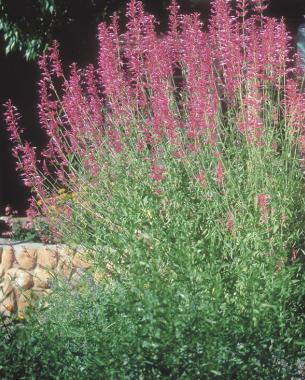
There are many companion plants for hyssops, which together can create a kaleidoscope of fragrance, color, and texture in your garden. Traditional perennial herbs like lavenders (Lavandula spp. and cvs., Zones 5–10), rosemarys (Rosmarinus spp. and cvs., Zones 8–10), garden sages (Salvia officinalis and cvs., Zones 5–8), and santolinas (Santolina spp. and cvs., Zones 6–9) are superb, contributing not only their colorful flowers and textured foliage to combinations but also incredible fragrance as well. Plant them where visitors will brush them when walking by to create a living potpourri.
Summer-blooming grasses like switch grasses (Panicum virgatum and cvs., Zones 5–9), feather reed grasses (Calamagrostis × acutiflora and cvs., Zones 5–9), Oriental fountain grasses (Pennisetum orientale and cvs., Zones 7–9), and needle grasses (Stipa spp. and cvs., Zones 7–10) are a great match, their tawny seed heads blending nicely with the hyssops’ pink, orange, and magenta flowers. Large-growing cacti and succulents provide a wonderful sculptural contrast to the towering spikes of large-flowered hyssops, re-creating the look of their native habitats.
Hyssops have it all. Plant them to add color, texture, structure, fragrance, and late-season bloom to your garden. The bees, butterflies, and hummingbirds will thank you.
Fine Gardening Recommended Products

Pruning Simplified: A Step-by-Step Guide to 50 Popular Trees and Shrubs
Fine Gardening receives a commission for items purchased through links on this site, including Amazon Associates and other affiliate advertising programs.

Lee Valley Large Gardener's Wash Basket
Fine Gardening receives a commission for items purchased through links on this site, including Amazon Associates and other affiliate advertising programs.

Nesco Snackmaster Express Food Dehydrator
Fine Gardening receives a commission for items purchased through links on this site, including Amazon Associates and other affiliate advertising programs.

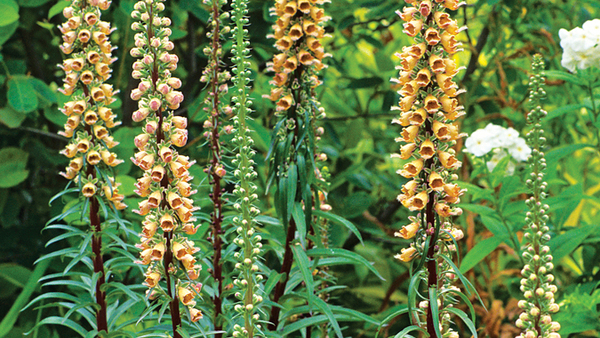
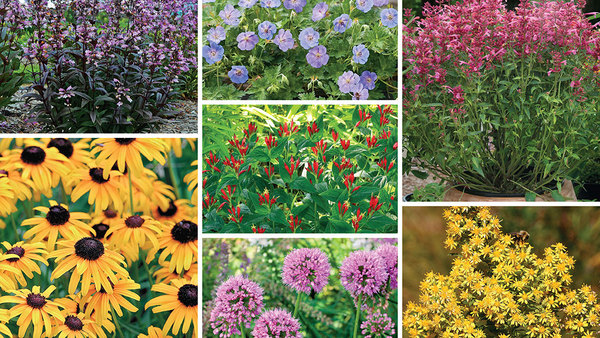
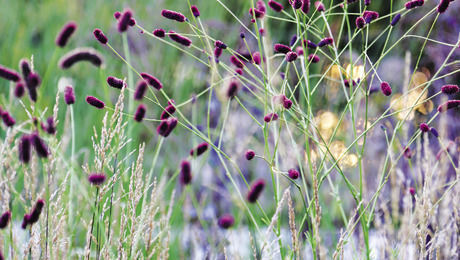
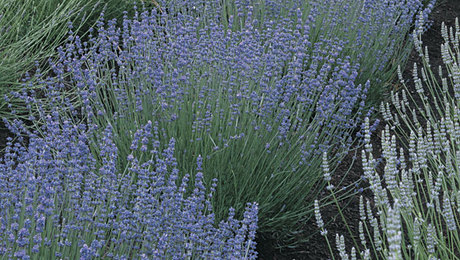













Comments
Log in or create an account to post a comment.
Sign up Log in